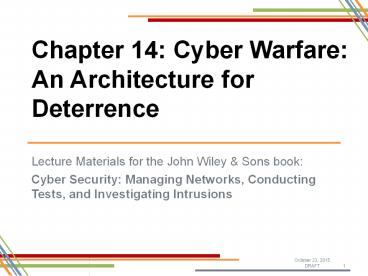Lecture Materials for the John Wiley - PowerPoint PPT Presentation
Title:
Lecture Materials for the John Wiley
Description:
Chapter 14: Cyber Warfare: An Architecture for Deterrence Lecture Materials for the John Wiley & Sons book: Cyber Security: Managing Networks, Conducting Tests, and ... – PowerPoint PPT presentation
Number of Views:88
Avg rating:3.0/5.0
Title: Lecture Materials for the John Wiley
1
Chapter 14 Cyber Warfare An Architecture for
Deterrence
- Lecture Materials for the John Wiley Sons book
- Cyber Security Managing Networks, Conducting
Tests, and Investigating Intrusions
2
Introduction to Cyber Warfare and Cyber
Deterrence
- Over 120 countries are actively conducting cyber
operations, primarily espionage - It is estimated that the Chinese have over
100,000 activity duty cyber warriors, and over
independent 80,000 hackers, who often carry out
mission in the national interest - As stated in CNCI 10, cyber deterrence is a
strategy that will deter interference and attack
in cyberspace and developing appropriate
responses by both state and non-state actors.
3
Methodology and Assumptions
- Cyber deterrence is a cutting edge research
problem, a very difficult one, in particular
because attributing cyber activities is so
difficult due to the technology - This research approach considers
- National Security Goals
- Cyber Warfare Laws Treaties
- Strategic Functions
- Solutions Architecture for Cyber Deterrence
- Technical Functions
4
Methodology Assumptions 2
5
Cyber Deterrence Challenges
- Assigning attribution
- Internet technology makes it relatively easy to
misdirect attribution to other parties - Unpredictability of cyber attack impacts
- Potential damage due to counter-retaliation
- Nation states, non-state actors, and individuals
are at a peer level, all capable of waging
attacks - No clear legal framework exists
6
Legal and Treaty Assumptions
- Legality of cyber operations should be clarified
in national and international treaties (allowing
for non-disclosure) - Monitoring of suspected remote servers should be
allowed,and attacked if they are
non-life-critical, because servers used for
attack may belong to unaware 3rd parties - Use of 3rd party servers should be defined
unlawful according to the laws of war - International investigations should be enabled
7
Cyber Deterrence Strategy
Used in the book With permission from The RAND
Corporation Libicki 2010
8
Cyber Deterrence Retaliation Probabilities
(Sample)
Used in the book With permission from The RAND
Corporation Libicki 2010
9
Reference Model
10
Attacker Conceptual Architecture
11
Conceptual Application Architecture Rapid
Attribution
12
Conceptual Information Architecture Sample Record
- RECORD 1
- 'IPv4 Address' '173.201.21.161', 'FTP Open on
Port' '21', 'RDP Open on Port' '3389', 'Ping
Response''Alive', 'Attack Organization'
'Aurora', 'Attack Role' 'Control Server' - RECORD 2
- 'IPv4 Address' '69.164.192.46', 'Ping
Response''Alive', 'Attack Organization'
'Aurora', 'Attack Role' 'Control Server' - RECORD 3
- 'IPv4 Address' '168.95.1.1', 'Ping
Response''Alive', 'Attack Organization'
'Aurora', 'Attack Role' 'Control Server' - RECORD 4
- 'IPv4 Address' '203.69.66.1', 'Ping
Response''Alive', 'Attack Organization'
'Aurora', 'Attack Role' 'Control Server
13
Architectural Prototypes
- Bot with Threaded Scanning
- Botnet with Distributed Scanning
Performance Actuals
Performance Projected
14
REVIEW Chapter Summary
- Cyber Security Managing Networks, Conducting
Tests, and Investigating Intrusions































